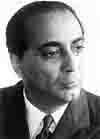
| Homi Jehangir Bhabha (1909 - 1966) |
Homi Jehangir Bhabha was born in an aristocratic family on October 30, 1909 as the son of a barrister. He passed the Senior Cambridge Examination when he was sixteen and went to Cambridge to earn his degree in Mechanical Engineering in Gonvile and Caius College. Mathematics and theoretical Physics were subjects which fascinated him.
His research began at the Cavendish Laboratories in Cambridge and his first paper was published in 1933. He received his PhD in 1935 and continued to stay in Cambridge till 1939. During his stay at Cambridge, he met scientists like Neil Bohr and Fermi. Bhabha returned to India and in 1940, CV Raman , the then Head of the Department of Physics, IISc requested Bhabha to join IISc. Bhabha joined the institute as a Reader in Physics. He started his research on Cosmic rays.
In 1942, he was elected as a member of the Royal Society and later as a Fellow of the Indian Academy of Sciences and went on to become the President of the Physics section of the Indian Science Congress in 1943. Bhabha aproached the visionary JRD Tata for starting an institute devoted to fundamental research and that resulted in the Tata Institute of Fundamental Research (TIFR). Bhabha was the Director of TIFR and held the position till his last day. In March 1944, Bhabha initiated efforts to start nuclear research programmes to make India self sufficient in the technology. Work directly related to the exploitation of nuclear energy for the benefit of India was started with the passing of the Atomic Energy Act in April 1948 and the setting of the Atomic Energy Commission a few months later in August 1948. On January 3, 1954, the Atomic Energy Commission decided to set up the Atomic Energy Establishment at Trombay where some work on atomic minerals was already under way. On August 3, 1954, the Department of Atomic Energy (DAE) was created with Bhabha as Secretary to the Government of India for the Department.
He gained international recognition for his excellent work and served as the President of the United Nations Conference on the Peaceful Uses of Atomic Energy which was first held in Geneva in 1955. He was the President of the International Union of Pure and Applied Physics from 1960 to 1963. He died in a plane crash on Mount Blanc on January 24, 1966.
| Back |